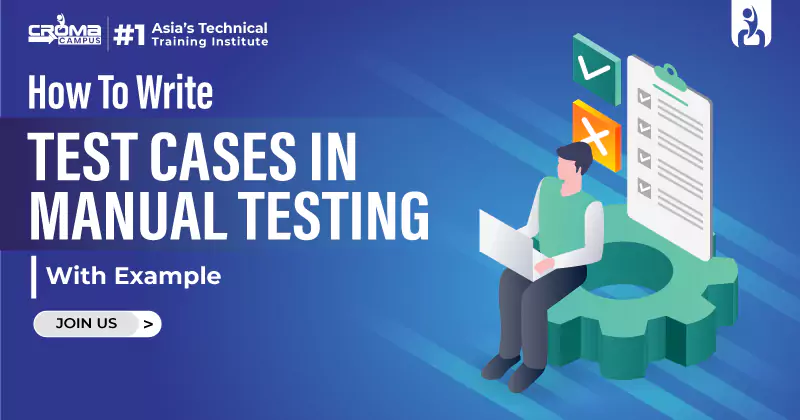Software Testing Strategies In Software Engineering
4.9 out of 5 based on 8989 votesLast updated on 6th Feb 2024 5.8K Views
- Bookmark

Software testing ensures quality by systematically validating and verifying software. Strategies include manual and automated testing to detect and fix defects.

This blog covers the distinctions between test strategy and test plan, various types of software testing strategies, and provides insights into crafting an effective software testing strategy. Key takeaways summarize the key points for readers.
- Overview
- Test Strategy vs Test Plan
- About Software Testing Strategy
- Types of Software Testing Strategy
- Static Testing Strategy
- Structural Testing Strategy
- Behavioural Testing Strategy
- Front-End Testing Strategy
- Software Testing Strategy Principles
- Key Takeaways
Overview:
Testing software is a critical step in the development process to guarantee it functions correctly before it's available to the public. The rigor of software testing is essential for user satisfaction and to prevent complaints. Negative reviews and poor word of mouth can be detrimental to your software's success in the market, and may even deter staff from using it. This principle extends to websites; a glitchy website can deter visitors, harm your reputation, and, consequently, reduce sales.
However, effective software testing strategies exist to mitigate such problems. A robust strategy tests the software under various conditions, including unexpected scenarios. For instance, it examines how the software behaves when users click the wrong button, input excessive variables, or introduce unusual characters.
In this blog, we will explore different software testing strategies and how to develop an effective software testing strategy to identify and rectify issues before they become problems.
Test Plan and Test Strategy – The Differences
Explore essential Software Testing Test Strategies in the Software Testing course, covering techniques for ensuring software quality and reliability through practical application and theory. Many individuals seek clarity on the distinction between a test plan and a test strategy. While both aim to ensure that software functions flawlessly, several differences set them apart.
Test Plan
A test plan primarily focuses on determining the effort required to approve the application/software after rigorous testing. This document encompasses details such as objectives, timelines, methodologies, estimations, and resources necessary for software testing. It is meticulously observed and guided by a test manager overseeing the entire process. Additionally, the test plan delineates the specific criteria for test approval, comprehensive testing details, and more.
Test Strategy
A test strategy is a compilation of directives and protocols that expound on test design and execution. It outlines the testing approach, defining what must be accomplished and how to achieve it. A single test strategy can be adapted to formulate multiple test plans.
Test Strategy vs. Test Plan: Core Differences
Now, let's delve into the core distinctions between test strategies and test plans.
|
Parameter |
Test
Strategy |
Test Plan |
|
Objectives |
It defines
overarching principles for the testing process. |
It
specifies the details of testing execution, including what, when, who, and
how to test. |
|
Purpose |
It acts as a long-term roadmap
for the entire testing project. |
It is geared toward identifying
and addressing potential defects during testing. |
|
Scope |
Focuses on
higher-level testing approaches and strategies. |
Encompasses
all testing activities comprehensively. |
|
Types |
Test strategies include
standard-compliant, methodical, model-based, analytical, reactive,
consultative, and regression-averse strategies. |
Test plans can be type-specific,
level-specific, or master test plans. |
|
Level
of Detail |
Test
strategy forms a component of the test plan, outlining the overall testing
approach. |
The test
plan is a separate document detailing common testing requirements for a
specific item. |
|
Performed
by |
Typically created by the project
manager or test manager, defining which modules to test and the testing
methods to follow. |
Usually developed by a lead or
testing manager, specifying when to test, who will perform the tests, how to
test, and what to test. |
Understanding these differences is crucial for effective software testing. Both the test strategy and test plan play essential roles in ensuring the quality and reliability of software products.
You May Also Read:
Different Types of Software Testing
Data Flow Testing in Software Testing
Black Box Testing in Software Engineering
About Software Testing Strategy
When embarking on a software testing project, two critical factors take the spotlight: strategy and investment. An investment in software testing is a substantial commitment, and strategy serves as the guiding light for making informed decisions. Without a well-defined strategy, it's virtually impossible to gauge the required investment accurately.
The very first stride in shaping a software testing strategy is gaining a comprehensive grasp of the most effective testing strategies at your disposal. Software testing isn't a one-size-fits-all domain; it encompasses a multitude of distinct approaches and techniques.
- Understanding Testing Techniques: The diverse landscape of software testing techniques necessitates a thorough understanding. Some tests delve deep into the code, demanding an intimate comprehension of the codebase and the underlying system. In contrast, other testing approaches require a less intricate understanding. Recognizing which techniques align best with your project's objectives is pivotal.
- Manual vs. Automated Testing: Another pivotal choice involves the decision to conduct manual testing or automated testing. Manual testing is a hands-on process where testers meticulously evaluate the software for issues. Automation, on the other hand, involves scripting tests and using specialized tools to execute them. The choice between these two methods hinges on factors like the project's scale, complexity, and resources.
- Technical Skill and Tools: The software testing strategy isn't solely about selecting the right techniques but also identifying the requisite technical skills and tools. Various testing strategies demand different levels of technical proficiency. Furthermore, the tools you employ significantly impact testing efficiency. Thus, it's essential to align your strategy with the available skill set and toolset.
A well-crafted software testing strategy optimizes resources, enhances testing efficiency, and ultimately contributes to the delivery of a reliable, high-quality software product. It acts as the compass guiding the entire testing journey, ensuring that the chosen testing techniques, manual or automated processes, and tools harmoniously align with the project's unique requirements.
Know More About:
Tosca Certification
Automation Software Testing Course
Jira Course
Types of Software Testing Strategy
There are 04 major types of software testing strategies, these are:
- Static Testing Strategy
- Structural Testing Strategy
- Behavioural Testing Strategy
- Front-End Testing Strategy
Let’s start discussing each of them in detail below:
Static Testing Strategy
Static testing assesses system quality without executing the actual software. It helps detect issues early, saving time and resources. Examples include code reviews and requirement evaluations, conducted by developers and domain experts.
- Desk-Checking: Developers review code before integration.
- Review Meetings: Evaluate requirements, design, and code.
- Efficiency: Early issue detection prevents bugs during runtime.
- Automation: Tools like 'lint' and 'JTest' for code analysis.
- Timing Matters: Reviews must be timely.
- Stakeholder Involvement: Multiple perspectives ensure comprehensive feedback.
Incorporating static testing in the software development process enhances quality and reduces post-implementation issues.
Know More About:
ISTQB Certification Cost
Manual Testing Course
Structural Testing Strategy
In the landscape of software testing, it is essential to delve beyond the surface and embrace a comprehensive approach. Enter structural testing strategy, a methodical and insightful process that goes beyond mere functionality testing. It aims to uncover the inner workings of the software, ensuring its robustness and reliability.
Key Aspects of Structural Testing Strategy:
- In-Depth Examination: Structural testing strategy is all about in-depth scrutiny, delving into the software's internal architecture to assess its integrity thoroughly.
- Microscopic View: Unlike black-box testing, which observes software from a user's perspective, structural testing peers into the intricacies of individual components and interfaces.
- White-Box Insight: Also known as "white-box testing," this approach demands a profound understanding of the software's internal mechanisms.
Bolstering Software Quality:
- Structural testing strategy isn't just about spotting defects; it's a proactive effort to enhance software quality.
- By identifying and rectifying issues at their core, this strategy ensures that the software remains resilient, reliable, and robust.
Comprehensive Evaluation:
- This strategy involves meticulously examining the code, data flow, algorithms, and data structures.
- It helps uncover hidden vulnerabilities and ensures that the software functions seamlessly in real-world scenarios.
Driving Continuous Improvement:
- A well-executed structural testing strategy contributes to ongoing software enhancement.
- It acts as a safeguard, preventing the emergence of critical issues and maintaining the software's integrity over time.
In the ever-evolving landscape of software development, a robust structural testing strategy is indispensable and helps to make a software application stand out.
Behavioral Testing Strategy
In the realm of software testing, the Behavioral Testing Strategy stands as a pivotal approach that centers on how a system behaves from an end-user's perspective. Unlike structural testing which delves into the software's internal mechanisms, Behavioral Testing examines the external actions and responses of a website or application.
Key Aspects of Behavioral Testing Strategy:
- User-Centric Approach: It focuses on understanding how different user profiles interact with the software.
- Holistic Evaluation: Behavioral Testing spans various aspects, including workflows, configurations, and performance, ensuring that all facets of the user journey are assessed.
The Essence of Behavioral Testing:
- These tests are akin to a user's experience with a website or application, assessing it from an end-user's viewpoint.
- Behavioral Testing, often referred to as "black box" testing, serves as a significant quality assurance tool.
Comprehensive Testing:
- Covering diverse user profiles and usage scenarios ensures that the software caters to a broad spectrum of users.
- Emphasis is placed on evaluating fully integrated systems to gauge the software's real-world behavior.
Manual and Automated Testing:
- While manual testing requires meticulous planning and design, it offers an insightful understanding of how users may interact with the software.
- Automation, on the other hand, tackles repetitive actions, such as regression tests, ensuring that new code doesn't disrupt existing features. This automation saves time, and effort, and minimizes the risk of human error.
The Balance Between User Perspective and Technical Insight:
- Testers walk a fine line, requiring a balance between understanding the software's functionality and having insight into the user's expectations.
- They must craft test scenarios based on user behavior predictions to ensure the software aligns with user needs.
Behavioral Testing Strategy, an essential component in the realm of software testing, serves as a user-centric guardian of quality. It ensures that software isn't just functional but also user-friendly, catering to a diverse user base and delivering exceptional experiences. By assessing how software behaves in real-world user interactions, we can enhance its usability, performance, and overall quality.
You May Also Read: Software Testing Interview Questions
Front-end Testing Strategy: Elevating User Experiences
In the ever-evolving landscape of software testing, the Front-end Testing Strategy takes center stage as a critical approach dedicated to enhancing user experiences. Unlike back-end testing, which scrutinizes the hidden intricacies of a software system, Front-end Testing zeros in on what users see and interact with.
Key Aspects of Front-end Testing Strategy:
- User-Centric Focus: It revolves around ensuring that the user interface (UI) is intuitive, responsive, and user-friendly.
- Cross-Platform Compatibility: Front-end testing extends its reach to diverse platforms and browsers, guaranteeing a seamless experience for all users.
The Essence of Front-end Testing:
- It is akin to a meticulous review of the software from a user's standpoint, verifying that the UI is not only visually appealing but also highly functional.
Comprehensive Front-end Testing:
- Ensures that the front-end components, including web pages, mobile apps, and graphical interfaces, operate flawlessly across various devices and browsers.
- It assesses responsiveness, ensuring that the software adapts to different screen sizes and resolutions.
Manual and Automated Testing:
- Manual testing delves into the finer details, identifying UI issues and assessing overall user experience.
- Automation takes on repetitive tasks, such as compatibility testing across multiple browsers and platforms, streamlining the process.
Striking the Balance:
- Front-end testers must strike a harmonious balance between a keen understanding of the software's visual elements and how users will interact with the UI.
- To create effective test scenarios, they need to anticipate user behavior and verify that the software aligns with these expectations.
Front-end Testing Strategy plays a pivotal role in the world of software quality assurance by focusing on what truly matters: the end user's experience.
Principles of an Effective Software Testing Strategy
To craft a successful testing strategy tailored to your objectives and yield efficient results, it's essential to adhere to certain key principles. When formulating a QA testing strategy, consider the following principles:
- Clear Objectives: Your testing endeavors should be driven by well-defined and explicit goals. This clarity guides your efforts and ensures that you're evaluating the right aspects of the product.
- Comprehensive Coverage: Your testing plan should encompass all facets of the product, encompassing functionality, performance, security, and usability.
- Early Testing: Initiating testing at an early stage in the development process is paramount. It's not only more cost-effective but also easier to address issues as they surface.
- Collaboration: Testing is a collaborative effort, necessitating close cooperation between developers, testers, and other stakeholders. This collaboration ensures everyone works in unison towards common objectives.
- Automation Integration: Automate as much as possible, as automation can significantly save time and effort.
- Continuous Evaluation: Testing should be an ongoing, iterative process rather than a one-time event. This approach ensures prompt identification and resolution of issues.
- User-Centric Focus: Your testing initiatives should revolve around meeting the needs and expectations of your end-users. This user-centric approach ensures the product's suitability for its intended audience.
Key Takeaways:
In conclusion, the significance of Software Testing cannot be overstated in the development and release of software. Whether you're delivering software to the market or utilizing it internally, the formulation of comprehensive software testing strategies and plans is imperative. The key components outlined above represent fundamental aspects of such a strategy and provide a blueprint for executing effective software testing.
Initiating testing at an early stage is not merely a cost-effective approach but also a strategic one, leading to the creation of a superior product and higher user satisfaction, be it among customers or internal staff. In essence, a well-structured software testing strategy is the cornerstone of ensuring the quality, reliability, and success of your software products.
Subscribe For Free Demo
Free Demo for Corporate & Online Trainings.

























.webp)

.png)















